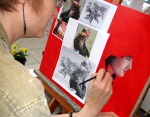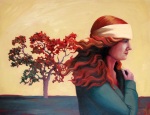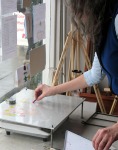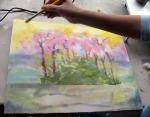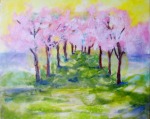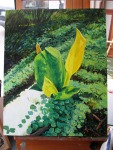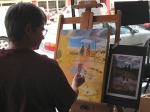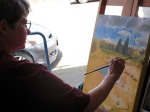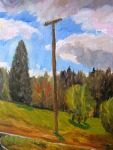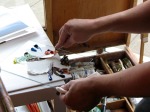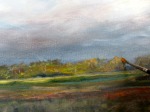Thanks to guest writer Sally Murdoch for today’s post.
Mandy Main is a virtuoso of vantage points. It all began as a child in Bellingham, Washington where the home in which she grew up had panoramic views of the Puget Sound and the San Juan Islands. While moving up and down the West Coast, including attending college at Stanford and earning her Masters at UCLA, Mandy’s subsequent homes came equipped with sweeping vistas. In North Portland, her family’s home on Willamette Ave, was appropriately in the Overlook area, with views of wooded Forest Park and the shipyard. And in SE Portland, near Mt. Tabor, Mandy could see the West Hills. Upon becoming a professional artist a decade ago, she knew how important light bouncing off hills would be to her eyes. In her painting, capturing the longest view possible is what holds her imagination.
Mandy painted for An Artist a Day in 2009. She skipped 2010 because she had recently moved to Rancho Mirage, near Palm Springs, CA where she and her husband live today. This week she returns as a guest artist on a lucky coincidence that her contemporary landscapes are part of a group show at Art Elements in Newberg.
Although Mandy didn’t quit her day job until 10 years ago, she has been painting steadily for two decades. Her landscapes incorporate very low horizons with reaching vantage points. Today she is painting an area south of Cannon Beach called Hug Point, a scene she chose to paint because she likes the diagonal line of the water coming into the shore, stretching the eye into the horizon.
Since moving from one very rainy place to a very sunny one, her landscapes have changed slightly, but she usually doesn’t paint desert landscapes. She often paints the mountains of Northern California that are smoother, almost “like sleeping beasts, organic and sculptural” she says, than the hills of Palm Springs.
She said the whole time she painted in Oregon she didn’t use blue paints for the skies; she used a variation of blue grays. In the desert where she lives now, the crystal clear skies mean true blue paints to capture the light bouncing off the hills.
Her heart is with 19th century American landscapes, and she feels fortunate to have lived in a lifetime where classic landscapes have returned in vogue and have seen commercial success.
The materials she is using today include: Galkyd medium made by Gamblin. MGraham oil paints, which incidentally she learned to paint with. Today she discovered a new paint: Michael Harding unbleached titanium, which she said is unlike any color she has ever gotten out of a tube.
Mandy loves her new home in the desert but comes back to Portland often enough to take part in art openings, the Mt. Tabor Art Walk (she was one of organizers) and she is a long time donor to Cascade Aids Project’s Annual Art Auction.
Note from Muse: Since Mandy had just come in from out of town, we prepped a wooden panel for her in advance with a base layer of color. We didn’t quite get it right (too much solvent perhaps) and the paint did not want to layer onto the surface. Mandy graciously made the best of the situation and worked on two quite different paintings — one on the panel using painting knives, and one on a canvas using brushes. She’ll continue work on one or both pieces over the next couple days and we’ll post an update with a picture of her finished work. UPDATE: The last two pictures are the two pieces that Mandy completed for the auction, the first is on a wooden panel, the second on canvas
Click on thumbnails to see larger pictures.



















